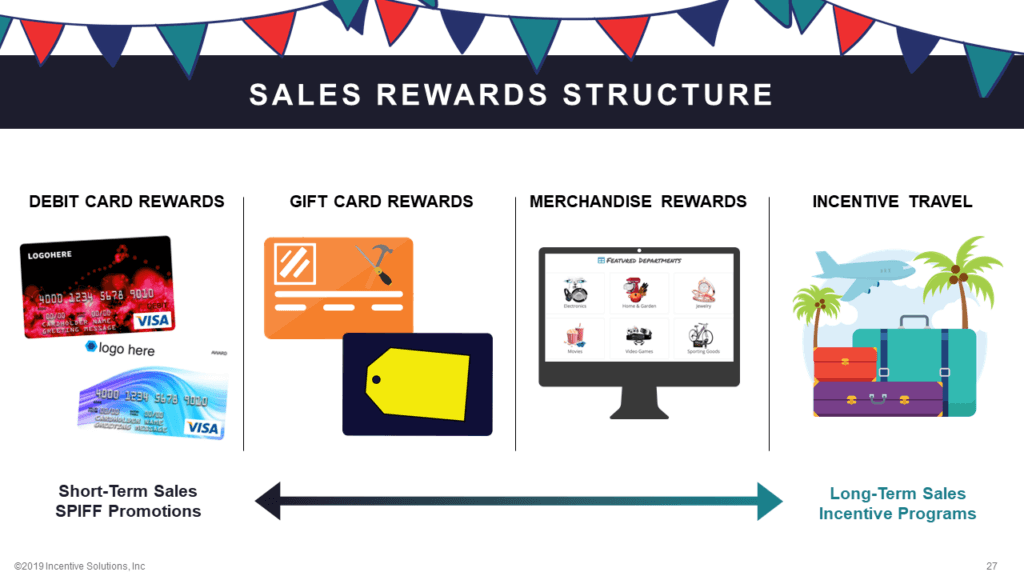Should you use sales SPIFFs or invest in a long-term sales incentive program? Well, that depends on your goals. A sales SPIFF is a short-term, seller side promotion, where direct or indirect sales reps are paid an immediate bonus for selling a specific product. Sales SPIFFs are strictly results-based. On the other hand, a long-term sales incentive program is an ongoing investment in your salesforce.
A long-term sales incentive program can also include performance-based promotions (similar to SPIFFs). However, sales incentive programs present opportunities for engagement, education, and enablement that a SPIFF program usually doesn’t.
Reward Structure for Sales SPIFFs vs. Long-Term Sales Incentive Programs
Of course, reward structure differs depending on whether you’re targeting short-term or long-term sales growth. Rewards for sales SPIFFs usually come in the form of reloadable debit card rewards, gift card incentives, or limited merchandise rewards. Usually rewards for sales SPIFFs focus more on short-term motivation, rather than memorability and relationship-building.
A long-term sales incentive program, on the other hand, features more scalable and emotionally impactful rewards. For instance, a sales incentive program would feature high-end merchandise rewards, custom reward fulfillment, or exclusive incentive travel rewards to build loyalty with top sales reps and channel partners, in addition to smaller rewards for incremental growth.

Goal Alignment: Does a Short-Term or Long-Term Investment Make More Sense?
SPIFFs are lower investment and focus more on short-term results. This comes at the cost of personalization and relationship-building. However, in a lot of instances, this might make more sense for an organization, depending on their goals and their audience.
When to Use Sales SPIFFs
You would probably use SPIFF promotions in the following situations:
- You are incentivizing part-time resellers or indirect sales reps who will not have an impact on your long-term goals.
- You are trying to motivate a large potential audience, in which you are unsure who your top performers will be.
- You are selling into a channel where you are unlikely to build long-term brand loyalty.
- You are trying to give sales a short-term boost over a specific time period or in a targeted region.
- You are attempting to gain traction and accelerate adoption for a new product launch, or you are trying to clear out old inventory to save on carrying costs.
- Your target sales reps don’t generate enough sales volume at a high enough margin to justify significant investment.
When to Use Long-Term Sales Incentive Programs
Sales incentive programs are more useful for targeting long-term objectives and strategies. A long-term sales incentive program would be more effective for the following organizational goals:
- You are incentivizing indirect sales reps and channel partners who are an integral part of your go-to-market strategy and who will have a long-term impact on your organizational goals.
- Sales reps for your industry are in high demand, require specific training and product knowledge, and are difficult to replace.
- You are attempting to build partnerships with other businesses and indirect sales reps within your channel.
- Your target sales reps require sales enablement and training to effectively sell your products to end-users.
- You are using your sales incentive program as a source of data and analytics to inform your sales and marketing strategy.
Which Strategy is in the Best Interests of Your Customers?
Before deciding to use sales SPIFF promotions or a long-term sales incentive program, it’s important to consider the implications on the customer experience for end-users. Choosing to incentivize the wrong KPIs can unintentionally result in sales behaviors that damage customer relationships. SPIFFs, especially, create this risk, since they are rewarded strictly based on sales metrics.
Sales incentive programs, on the other hand, can be structured to motivate other behaviors – such as improved client follow-up or product training – that result in a better customer experience in addition to increasing sales.
Companies in industries such as insurance sales, medical sales, or sales to government agencies should be especially careful about the KPIs they choose to incentivize. For these industries, SPIFFs can result in ethical or legal implications. Generally, a long-term sales incentive program is a safer bet.
SPIFFs vs. Long-Term Sales Incentives – Why Not Use Both?
However, it’s important to keep in mind: short-term results and long-term sales growth don’t have to be mutually exclusive. In fact, they’re often intertwined. Mixing in sales SPIFFs with your long-term sale incentive program lets you tackle both strategic and tactical sales goals. For many organizations, this approach offers the best of both worlds.
For more information about sales incentive software that lets you structure multiple promotions and isolate reporting to measure ROI, we encourage you to sit down with us for a free organizational analysis and tech demo so that we can start planning the right approach for you!



